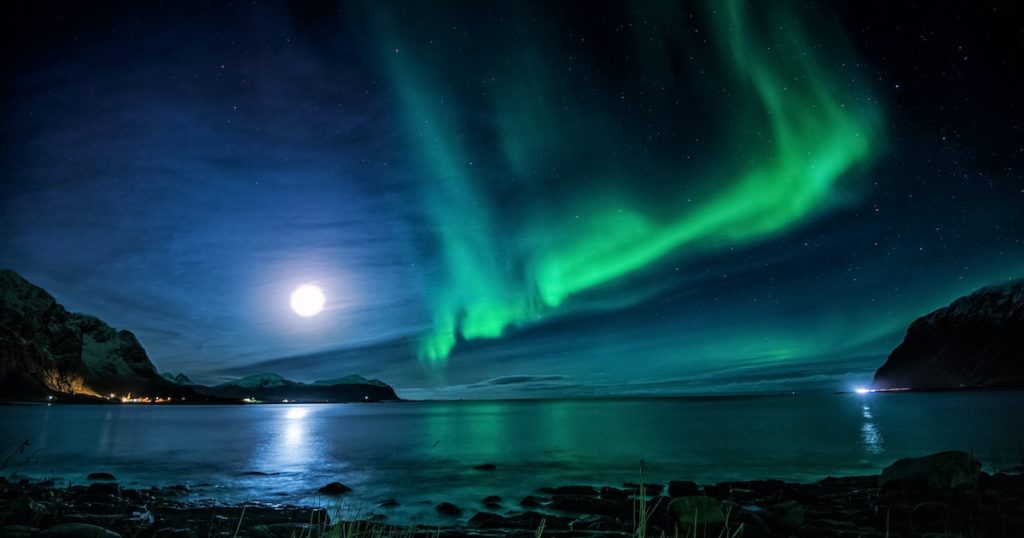For tens of thousands of years, the North Pole has held a special place in human imagination and mythology. Across ancient cultures and belief systems, it has been regarded as the home of gods, a sacred mountain, and a place where worlds connect. Even today, the North Pole continues to captivate our imaginations, inspiring literature, and find itself as the home of our modern-day myth of Father Christmas. By connecting ancient myths with emerging scientific discovery, will we unlock the mysteries surrounding the magic of the North Pole?
The North Pole in Ancient Myths and Religions
- Norse Mythology: Asgard, the realm of the gods in Norse mythology, has been associated with the North Pole due to its proximity to the Viking lands. Asgard could be reached from earth only by the bridge Bifrost or Rainbow. Asgard was said to be divided into 12 other worlds of the gods including Valhalla with each god having their own palace in these 12 other worlds.
- Hyperborea in Greek Mythology: Hyperborea, a legendary land ‘beyond the reach of the North Wind’, has often been associated with the North Pole. It was described as a place where the sun only rose and set once a year. It was reported by several notable Greek and Roman writers to be inhabited by people who lived to the age of 1000 and according to the writings of Aelian, the Hyperboreans were described as being 6 cubits tall (2.7m). The Greek god Apollo was said to spend his winters in Hyperborea and various ancient texts mentioned the Hyperboreans, including Plato who wrote of ‘Abaris the Healer’ from Hyperborea.
- The Tuatha de Danann, god-like beings in Irish Mythology, were said to originate from the North, and bear a resemblance to the descriptions of the Hyperboreans, further emphasising the region’s significance in ancient mythology.
The Sacred Mountain at the North Pole
- In Hinduism, Jainism and Budhism, Mount Meru has been associated with the North Pole due to the connection with the word Meru and the word ‘axis’. Mount Meru is considered the centre of the universe, and is considered to be the ‘centre of all the physical, metaphysical and spiritual universes.’
- Arabic traditions, including Sufism, mention Mount Qaf, as a “farthest point of the earth”. Mount Qaf was said to be covered in Emerald, home of the Jinn and a ‘ place beyond which the unseen divine world begins.’
- Both of these concepts reflect the Greco-Roman idea of a divine ‘axis mundi’ connecting heaven and earth, often associated with the North Pole.
The Magic of the North Pole in Shamanic Traditions
Indigenous shamanic cultures like the Chucki and Sami have traditions involving journeys to the North Pole in altered states of consciousness, underlining its mystical appeal. The origin of shamanism in Siberia could also link to a tradition that descends from an ancient advanced culture in the North Pole.
An Ancient Fascination with the Northern Lights
The Northern Lights, or Aurora Borealis, have been a source of fascination for people worldwide for tens of thousands of years and have often been linked to the divine. Galileo Galilei named this phenomena ‘Aurora Borealis’ after the Roman Goddess of Dawn.
A 30,000-year-old cave painting in France of the Northern Lights proves the fascination and importance of this phenomena to early humans and demonstrates early human travel to the region, possibly for spiritual reasons. There is evidence of Babylonian astronomers inscribing the Northern Lights on a tablet in as early as 567 BC, again demonstrating the significance in far-reaching lands. We also find Chinese reports of the Northern Lights as early as 193 AD.
The North Pole on Early Maps
Throughout history, the North Pole was often viewed as a magnetic mountain surrounded by four countries. This belief influenced early maps, such as Martin Behaim’s globe in 1492 and Mercator‘s Arctic map in 1595. A Franciscan monk’s account of visiting the area and describing the magnetic rock and four continents, one of which was said to be inhabited by Pygmies in his book “Inventio Fortunata” contributed to these ideas.
The Magic of The North Pole in Modern Literature
In modern history, the North Pole maintains its association with mysticism and as a place where worlds connect:
- Philip Pullman’s famous trilogy features the North Pole and The Northern Lights as central elements, a place where multiple worlds connect.
- Margaret Cavendish’s 17th-century book “The Description of a New World, Called the Blazing World” also used the North Pole as an entry point to multiple universes.
- The connection between the North Pole and parallel worlds bears resemblance to many ancient myths surrounding the North Pole including the ancient Viking myth of Asgard
The Modern Enigma of the North Pole
The North Pole is a point where all 24 world time zones meet, where the sun sets only once per year and where time appears to stand still giving it a continued air of mystery. Due to the thick ice cover over the North Pole, underwater geography and what lies beneath the ice remains largely unexplored. The North Pole continues to be somewhat of an enigma, captivating modern scientific research including the Parker Solar Probe, an ongoing scientific project designed to better understand the still mysterious phenomena of the Northern Lights.
Climate Change, Scientific Exploration, and the Quest for Ancient Mysteries
The magic of the North Pole’s continues to beckon humanity to explore its secrets, both scientific and spiritual. As the ice sheets at the North Pole begin to melt due to climate change, this will allow more opportunities for scientific exploration. What might we find beneath the ice? Could these discoveries point to a deeper mystical or divine connection between the North Pole, celestial events, and Earth’s place in the cosmos? Will we uncover the magnetic rock and lost countries that have fuelled ancient myths for centuries?
